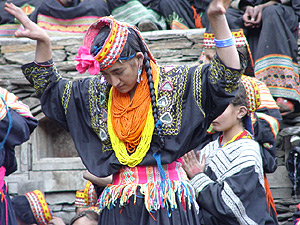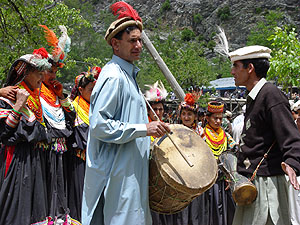Service & Area
Quick Links
Kalash Festival
 The Kalash are cheerful people, generous, witty and fond of rejoicing and merry making. Their women folk have an outgoing manner that is disarming, delightful and unexpected. As you join them in their festivities and see them dance and sing, you are taken right back into history.
The Kalash are cheerful people, generous, witty and fond of rejoicing and merry making. Their women folk have an outgoing manner that is disarming, delightful and unexpected. As you join them in their festivities and see them dance and sing, you are taken right back into history.
The Kalash have four colourful festivals.To the Kalash these festivals are the culmination’s of religious life and, like the big funerals, they unite the people.
“Joshi /Chilimjusht” the spring festival, in the middle of May lasts for four days. . The spring festival honours the fairies and allso safeguards the goats and shepherds before they go to the pastures. Before the festival the women and girls gather from all over the valley and decorate their houses. Inside the houses local wine and milk products are shared .  The women then sprinkle milk on Goddess “ Jestak “ the protector of their children and home. The festival begins at Rumbur where the Shaman ( soothsayer ) and tribal chiefs lead a procession to the “ Malosh altar” , high above Grum, to sacrifice goats to the Gods . Later the festival moves on to Bumboret and ends up at Birir , a few days later.
The women then sprinkle milk on Goddess “ Jestak “ the protector of their children and home. The festival begins at Rumbur where the Shaman ( soothsayer ) and tribal chiefs lead a procession to the “ Malosh altar” , high above Grum, to sacrifice goats to the Gods . Later the festival moves on to Bumboret and ends up at Birir , a few days later.
Every religious ceremony is accompanied by dancing and rhythmical chant to a beat of the drum. The women wearing their traditional black robes, ornate cowries shelled head dresses and adorned with coloured necklaces, dance in a circle. Then the men join in : it may be a man and a women or a man in the middle with a women on each side, lovers being free to intermingle. One hand is held round the waist of the partner and the other round the shoulders. Tribal chiefs in colourful dresses narrate stories of bygone days and events.
 Uchal festival, in Augusts marking the harvest of wheat and barley and bringing down of cheese from the high summer pastures. It is celebrated in Rumbur and Bumboret . Earlier in July it starts as the “ Ranat” with dances held on alternate days performed by the young girls and boys in order to safeguard the maize crop.
Uchal festival, in Augusts marking the harvest of wheat and barley and bringing down of cheese from the high summer pastures. It is celebrated in Rumbur and Bumboret . Earlier in July it starts as the “ Ranat” with dances held on alternate days performed by the young girls and boys in order to safeguard the maize crop.
Phoo festival, is only held in Birir around end of September to celeberate the grape and walnut harvest. Grape being a staple requirement in the Kalash society for making wine are grown on trees in protected sites. The holy tree being the best for such climbers. They are picked through out the valley on a particular day and is an occasion for joy and merry making.. It is also an occasion of the shepherds returning from the high pastures .
Chomos festival. As winter starts around mid December the Chomos festival begins . The festival is observed for the divine, the living and dead relatives, for the crops and the goats to be safeguarded, while the community, the village and the valley are purified prior to the coming year. Sighting a fox is a good omen and great efforts are made in this regard. At dusk torch lit processions are led from all the nearby villages culminating at the “Charsue” which is the main customary dancing place. Most of the festivities are indoors where the local wine is handed around as the dance gathers momentum carries out till late in the night round the bonfire. While the tribal elders sit on hill tops at dawn to watch the rising sun and declare the new year. Goat sacrifices are then made to the Godess “Jastak” , blood from the animal is sprinkled at the temple Jastak An. This is the time when “Balimine” another great God visits the Kalash valley once a year and sacrifices are made at his “ Malosh. Altar” too.
Most of the festivities are indoors where the local wine is handed around as the dance gathers momentum carries out till late in the night round the bonfire. While the tribal elders sit on hill tops at dawn to watch the rising sun and declare the new year. Goat sacrifices are then made to the Godess “Jastak” , blood from the animal is sprinkled at the temple Jastak An. This is the time when “Balimine” another great God visits the Kalash valley once a year and sacrifices are made at his “ Malosh. Altar” too.
Hindukush Trails runs regular trips to these festivals with private "home stays", to get to know more of the people and their culture and a chance to taste traditional local cuisines which you miss out while staying in hotels.
We organize package tours to all festivals in different regions of Pakistan.
